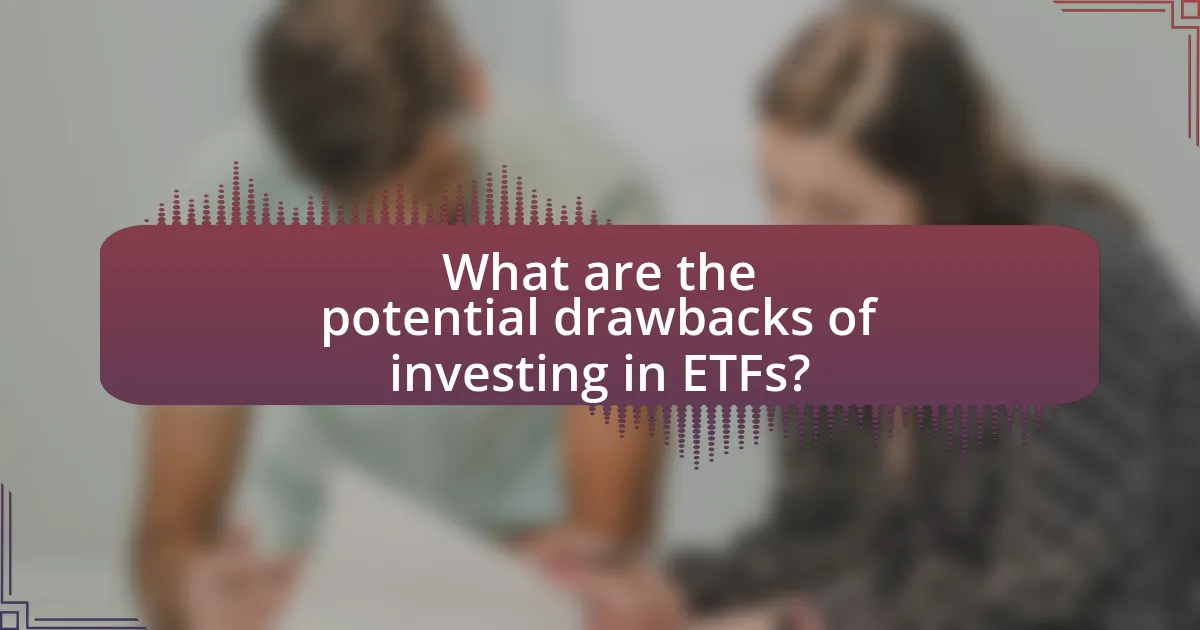Exchange-Traded Funds (ETFs) are investment funds traded on stock exchanges, allowing investors to pool their money into a diversified portfolio of assets such as stocks, bonds, and commodities. This article explores the functionality of ETFs within modern investment strategies, highlighting their liquidity, cost-effectiveness, and tax efficiency compared to traditional mutual funds. Key characteristics of ETFs, including their ability to provide diversification and lower expense ratios, are discussed, along with strategies for asset allocation and risk management. Additionally, the article addresses potential drawbacks and risks associated with ETF investments, emphasizing the importance of ongoing research and monitoring for effective portfolio management.

What are ETFs and how do they function in modern investment strategies?
ETFs, or Exchange-Traded Funds, are investment funds that are traded on stock exchanges, similar to individual stocks. They function by pooling investors’ money to purchase a diversified portfolio of assets, such as stocks, bonds, or commodities, which allows investors to gain exposure to a wide range of securities without needing to buy each one individually.
In modern investment strategies, ETFs are utilized for their liquidity, cost-effectiveness, and tax efficiency. They enable investors to easily enter and exit positions throughout the trading day, unlike mutual funds, which are only traded at the end of the day. Additionally, the average expense ratio for ETFs is lower than that of traditional mutual funds, making them a more affordable option for many investors. According to the Investment Company Institute, as of 2022, U.S. ETF assets reached approximately $6.6 trillion, reflecting their growing popularity in investment portfolios.
What are the key characteristics of ETFs?
Exchange-Traded Funds (ETFs) are investment funds that are traded on stock exchanges, similar to individual stocks. Key characteristics of ETFs include diversification, as they typically hold a collection of assets such as stocks or bonds, which reduces risk compared to investing in single securities. Additionally, ETFs offer liquidity, allowing investors to buy and sell shares throughout the trading day at market prices. They also have lower expense ratios compared to mutual funds, making them cost-effective for investors. Furthermore, ETFs are tax-efficient due to their unique structure, which minimizes capital gains distributions. These characteristics make ETFs a popular choice for modern investment strategies.
How do ETFs differ from traditional mutual funds?
ETFs, or Exchange-Traded Funds, differ from traditional mutual funds primarily in their trading mechanism and pricing structure. ETFs trade on stock exchanges like individual stocks, allowing investors to buy and sell shares throughout the trading day at market prices, which can fluctuate. In contrast, traditional mutual funds are bought and sold at the end of the trading day at a price determined by the net asset value (NAV), which is calculated after the market closes.
Additionally, ETFs typically have lower expense ratios compared to mutual funds, as they are often passively managed and do not incur the same level of management fees. According to a 2021 report by Morningstar, the average expense ratio for ETFs was 0.44%, while traditional mutual funds averaged 0.74%. This cost efficiency, combined with the flexibility of trading, makes ETFs a popular choice among investors seeking modern investment strategies.
What types of assets can be included in an ETF?
Exchange-Traded Funds (ETFs) can include a variety of asset types such as stocks, bonds, commodities, and real estate. Stocks are often the most common asset type, representing shares of publicly traded companies. Bonds can include government and corporate debt instruments, providing fixed income. Commodities may encompass physical goods like gold, oil, or agricultural products. Real estate assets can be represented through Real Estate Investment Trusts (REITs) within an ETF. This diversity allows investors to gain exposure to multiple asset classes within a single investment vehicle, enhancing portfolio diversification and risk management.
Why are ETFs becoming increasingly popular among investors?
ETFs are becoming increasingly popular among investors due to their low costs, tax efficiency, and diversification benefits. The average expense ratio for ETFs is significantly lower than that of mutual funds, often around 0.2% compared to 1% or more for actively managed funds. Additionally, ETFs typically have lower capital gains distributions, which enhances their tax efficiency. Furthermore, ETFs provide investors with exposure to a wide range of asset classes and sectors, allowing for easy diversification within a single investment. According to a report by the Investment Company Institute, assets in U.S. ETFs reached over $5 trillion in 2021, reflecting their growing acceptance and use among investors.
What advantages do ETFs offer over other investment vehicles?
ETFs offer several advantages over other investment vehicles, including lower expense ratios, tax efficiency, and greater liquidity. Lower expense ratios make ETFs more cost-effective compared to mutual funds, which often have higher management fees; for instance, the average expense ratio for ETFs is around 0.44%, while mutual funds average about 1.0%. Tax efficiency arises from the unique structure of ETFs, which allows investors to buy and sell shares without triggering capital gains taxes, unlike mutual funds that may distribute capital gains to shareholders. Additionally, ETFs trade on exchanges like stocks, providing greater liquidity and flexibility, allowing investors to buy or sell throughout the trading day at market prices. These factors collectively enhance the appeal of ETFs in a modern investment strategy.
How do ETFs provide diversification for investors?
ETFs provide diversification for investors by allowing them to invest in a broad range of assets within a single fund. This structure enables investors to gain exposure to various sectors, industries, or geographic regions, thereby reducing the risk associated with individual securities. For example, an ETF that tracks the S&P 500 includes shares from 500 different companies, which mitigates the impact of poor performance from any single stock. Additionally, according to a study by Vanguard, diversified portfolios can reduce volatility and improve risk-adjusted returns, demonstrating the effectiveness of ETFs in achieving a balanced investment strategy.

How do ETFs fit into a diversified investment portfolio?
ETFs, or Exchange-Traded Funds, fit into a diversified investment portfolio by providing broad market exposure, liquidity, and cost efficiency. They allow investors to gain access to a wide range of asset classes, including stocks, bonds, and commodities, which helps to spread risk across different sectors and geographies. For instance, a study by Morningstar found that portfolios including ETFs can achieve similar or better risk-adjusted returns compared to those without them, due to their inherent diversification benefits. Additionally, ETFs typically have lower expense ratios than mutual funds, making them a cost-effective choice for investors looking to diversify their holdings.
What role do ETFs play in risk management?
ETFs play a crucial role in risk management by providing diversification, liquidity, and cost-effectiveness. Diversification is achieved as ETFs typically hold a basket of securities, which reduces the impact of poor performance from any single asset. For instance, a study by Vanguard found that a diversified portfolio can lower risk by up to 30% compared to holding individual stocks. Additionally, ETFs offer liquidity, allowing investors to buy and sell shares throughout the trading day, which helps in managing market risk effectively. Their cost-effectiveness is evident as they generally have lower expense ratios compared to mutual funds, enabling investors to retain more of their returns. Thus, ETFs serve as a strategic tool for investors to mitigate risk while maintaining exposure to various asset classes.
How can investors use ETFs to hedge against market volatility?
Investors can use ETFs to hedge against market volatility by incorporating inverse or leveraged ETFs that are designed to move in the opposite direction of the market. These specialized ETFs allow investors to profit from market declines, effectively offsetting losses in their broader portfolio during downturns. For example, during the market volatility experienced in March 2020, inverse ETFs like the ProShares Short S&P 500 (SH) gained significant value as the S&P 500 index fell, demonstrating their effectiveness as a hedging tool. Additionally, investors can diversify their holdings through sector-specific ETFs that may perform better during turbulent times, such as utilities or consumer staples, which tend to be more resilient in volatile markets. This strategic use of ETFs enables investors to manage risk and protect their investments against adverse market movements.
What strategies can be employed using ETFs for asset allocation?
ETFs can be employed for asset allocation through strategies such as strategic asset allocation, tactical asset allocation, and core-satellite investing. Strategic asset allocation involves setting a long-term target allocation across various asset classes, such as equities, bonds, and commodities, and using ETFs to maintain these proportions. Tactical asset allocation allows investors to adjust their asset mix based on market conditions, utilizing ETFs to quickly shift investments in response to economic indicators or trends. Core-satellite investing combines a core portfolio of low-cost, broad-market ETFs with satellite positions in specialized or actively managed ETFs to enhance returns. These strategies leverage the liquidity, diversification, and cost-effectiveness of ETFs, making them suitable for various investment goals and risk tolerances.
How can investors select the right ETFs for their needs?
Investors can select the right ETFs by assessing their investment goals, risk tolerance, and the specific sectors or asset classes they wish to target. First, defining investment objectives, such as income generation or capital appreciation, helps narrow down suitable ETFs. Next, evaluating risk tolerance allows investors to choose ETFs that align with their comfort level regarding market volatility. Additionally, analyzing the underlying assets, expense ratios, and historical performance of the ETFs provides insight into their potential returns and costs. For instance, according to Morningstar, lower expense ratios often correlate with better long-term performance, making cost a critical factor in ETF selection.
What factors should be considered when evaluating an ETF?
When evaluating an ETF, key factors to consider include the fund’s expense ratio, liquidity, tracking error, and the underlying index it aims to replicate. The expense ratio indicates the cost of managing the ETF, with lower ratios generally being more favorable; for example, the average expense ratio for equity ETFs is around 0.44%. Liquidity, measured by average trading volume, affects how easily shares can be bought or sold without impacting the price. Tracking error reflects how closely the ETF’s performance aligns with its benchmark index, with lower tracking errors indicating better performance. Additionally, understanding the underlying index is crucial, as it determines the ETF’s investment strategy and risk profile. For instance, an ETF tracking a volatile sector may present higher risk compared to one tracking a broad market index.
How do expense ratios impact ETF selection?
Expense ratios significantly impact ETF selection by influencing the overall cost of investment. A lower expense ratio typically indicates a more cost-effective ETF, which can enhance net returns over time. For instance, a study by Morningstar found that over a 20-year period, a 1% difference in expense ratios can lead to a substantial difference in investment outcomes, with lower-cost funds outperforming higher-cost ones by an average of 1.5% annually. Therefore, investors often prioritize ETFs with lower expense ratios to maximize their potential returns while minimizing costs.

What are the potential drawbacks of investing in ETFs?
Investing in ETFs can lead to several potential drawbacks, including liquidity risks, management fees, and tracking errors. Liquidity risks arise when an ETF’s trading volume is low, making it difficult to buy or sell shares without impacting the price. Management fees, although generally lower than mutual funds, can still erode returns over time, especially in funds with higher expense ratios. Tracking errors occur when an ETF does not perfectly replicate the performance of its underlying index, which can result from factors like fund expenses and sampling methods. According to a 2021 report by Morningstar, the average expense ratio for ETFs was 0.44%, which, while lower than mutual funds, still highlights the importance of considering fees in investment decisions.
What risks are associated with ETF investments?
ETF investments carry several risks, including market risk, liquidity risk, tracking error, and management risk. Market risk refers to the potential for losses due to overall market fluctuations, which can affect the value of the ETF. Liquidity risk arises when an ETF cannot be bought or sold quickly enough without impacting its price, particularly in volatile markets. Tracking error indicates the discrepancy between the ETF’s performance and that of its underlying index, which can result from management decisions or operational inefficiencies. Management risk involves the potential for poor decisions made by the fund managers, which can negatively impact the ETF’s performance. These risks highlight the importance of thorough research and understanding before investing in ETFs.
How can liquidity issues affect ETF performance?
Liquidity issues can significantly impact ETF performance by increasing bid-ask spreads and reducing the ability to execute trades at desired prices. When an ETF experiences low liquidity, it may become more difficult for investors to buy or sell shares without affecting the market price, leading to higher transaction costs. For instance, during periods of market stress, liquidity can dry up, causing ETFs to trade at significant discounts or premiums to their net asset values (NAV). Historical data shows that during the 2008 financial crisis, many ETFs faced severe liquidity challenges, resulting in wider spreads and increased volatility. This demonstrates that liquidity is crucial for maintaining efficient pricing and minimizing trading costs in ETFs.
What are the tax implications of trading ETFs?
Trading ETFs can have significant tax implications, primarily due to capital gains taxes. When an investor sells an ETF for a profit, they may incur short-term capital gains tax if the holding period is less than one year, which is taxed at ordinary income rates. Conversely, long-term capital gains tax applies if the ETF is held for over a year, typically at lower rates ranging from 0% to 20%, depending on the investor’s income level. Additionally, ETFs are generally more tax-efficient than mutual funds because they utilize an “in-kind” creation and redemption process, which helps minimize taxable events. According to the Investment Company Institute, this structure allows ETFs to avoid triggering capital gains distributions, making them a more tax-efficient investment option.
How can investors mitigate the risks associated with ETFs?
Investors can mitigate the risks associated with ETFs by diversifying their holdings across various sectors and asset classes. Diversification reduces the impact of poor performance in any single investment, as evidenced by studies showing that a well-diversified portfolio can lower volatility and enhance returns. Additionally, investors should conduct thorough research on the underlying assets of the ETF, including their historical performance and market conditions, to make informed decisions. Utilizing stop-loss orders can also help limit potential losses by automatically selling shares when they reach a predetermined price. Furthermore, investors should regularly review and rebalance their portfolios to ensure alignment with their risk tolerance and investment goals, which is supported by financial literature emphasizing the importance of ongoing portfolio management.
What strategies can be used to minimize losses in ETF investments?
To minimize losses in ETF investments, investors can employ strategies such as diversification, stop-loss orders, and regular portfolio rebalancing. Diversification involves spreading investments across various sectors and asset classes to reduce risk; for instance, holding ETFs that track different industries can mitigate the impact of poor performance in any single sector. Stop-loss orders automatically sell an ETF when its price falls to a predetermined level, helping to limit potential losses. Regular portfolio rebalancing ensures that the investment allocation remains aligned with the investor’s risk tolerance and market conditions, which can prevent overexposure to underperforming assets. These strategies are supported by research indicating that diversified portfolios tend to have lower volatility and better risk-adjusted returns over time.
How important is ongoing research and monitoring for ETF investors?
Ongoing research and monitoring are crucial for ETF investors as they help in making informed investment decisions and managing risks effectively. ETFs can be influenced by various factors such as market trends, economic indicators, and changes in underlying assets. For instance, a study by Morningstar in 2021 highlighted that investors who actively monitored their ETF holdings and adjusted their portfolios based on market conditions achieved better returns compared to those who did not. This demonstrates that continuous research and monitoring enable investors to respond promptly to market dynamics, optimize their investment strategies, and enhance overall portfolio performance.
What best practices should investors follow when incorporating ETFs into their strategy?
Investors should prioritize diversification, cost efficiency, and thorough research when incorporating ETFs into their strategy. Diversification is achieved by selecting ETFs that cover various asset classes, sectors, or geographic regions, which can reduce risk. Cost efficiency is important as ETFs typically have lower expense ratios compared to mutual funds; for instance, the average expense ratio for ETFs was 0.44% in 2020, compared to 0.74% for mutual funds, according to Morningstar. Thorough research involves analyzing the underlying assets, performance history, and tracking error of the ETFs to ensure alignment with investment goals. By following these best practices, investors can enhance their portfolio’s performance and manage risk effectively.
How can investors effectively rebalance their ETF portfolios?
Investors can effectively rebalance their ETF portfolios by regularly assessing their asset allocation and adjusting their holdings to maintain their desired risk level. This process typically involves selling ETFs that have exceeded their target allocation and buying those that have fallen below it, ensuring alignment with the investor’s investment strategy. Research indicates that rebalancing can enhance returns and reduce risk; for instance, a study by Vanguard found that a disciplined rebalancing strategy can improve portfolio performance over time by mitigating the effects of market volatility.
What resources are available for ETF education and research?
Resources available for ETF education and research include online platforms, academic publications, and financial institutions. Websites like Investopedia and Morningstar provide comprehensive guides and articles on ETFs, covering their structure, benefits, and risks. Additionally, academic journals such as the Journal of Finance publish research studies that analyze ETF performance and market impact. Financial institutions, including Vanguard and BlackRock, offer educational materials and webinars to help investors understand ETF strategies and investment options. These resources collectively enhance investor knowledge and facilitate informed decision-making regarding ETFs.





